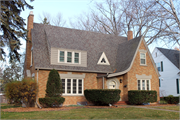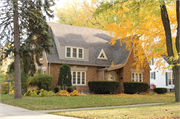Property Record
330 MIRAMAR DR
Architecture and History Inventory
| Historic Name: | EARL L. & MARGUERITE LAMBEAU HOUSE |
|---|---|
| Other Name: | |
| Contributing: | Yes |
| Reference Number: | 223317 |
| Location (Address): | 330 MIRAMAR DR |
|---|---|
| County: | Brown |
| City: | Allouez |
| Township/Village: | |
| Unincorporated Community: | |
| Town: | |
| Range: | |
| Direction: | |
| Section: | |
| Quarter Section: | |
| Quarter/Quarter Section: |
| Year Built: | 1930 |
|---|---|
| Additions: | |
| Survey Date: | 2012 |
| Historic Use: | house |
| Architectural Style: | English Revival Styles |
| Structural System: | Balloon Frame |
| Wall Material: | Brick |
| Architect: | |
| Other Buildings On Site: | N |
| Demolished?: | No |
| Demolished Date: |
| National/State Register Listing Name: | Miramar Drive Residential Historic District |
|---|---|
| National Register Listing Date: | 4/16/2018 |
| State Register Listing Date: | 12/1/2017 |
| National Register Multiple Property Name: |
| Additional Information: | Earl “Curly” Louis Lambeau was born in Green Bay in 1898. Growing up in a non-extant house on N. Jackson Street in the City of Green Bay, Lambeau attended Green Bay East High School, where he was captain of the football team in 1917. The following year, he played football at Notre Dame University. Curly was sent home after contracting tonsillitis at the end of that year and never returned. In 1919, he married Marguerite Van Kessel. The couple initially lived above the non-extant store of Marguerite’s parents on S. Monroe Avenue in the City of Green Bay. Later in 1919, while working for the Indian Packing Company, he co-founded the Green Bay Packers with George Calhoun of the Green Bay Press-Gazette. The Packers were established as a semi-professional organization, playing teams from Wisconsin and Michigan’s Upper Peninsula. The team played in a vacant lot at Hagemeister Park. Lambeau played halfback and was the team’s primary runner and passer. By 1921, Lambeau served as the team’s head coach concurrently while playing. In 1921, the Green Bay Packers joined American Professional Football Association, now known as the National Football League. The team lost their membership within the year, due to illegally recruiting college players. With the financial backing of Andrew B. Turnbull of the Green Bay Press-Gazette, Lambeau was able to get the Packers reinstated into National Football League in 1922. After Turnbull convinced local professionals to purchase stock in the team, the Green Bay Packers were established as a non-profit organization in 1923. By this time, Curly also began working as a salesman at Stiefel’s clothing store in the City of Green Bay. By 1925, Curly and Marguerite moved to a house on Grignon Street in the City of Green Bay. That same year, a stadium named City Stadium was constructed for the Packers behind Green Bay East High School. Curly retired from playing in 1929, continuing solely as head coach. In 1930, the Lambeaus had a house constructed in Allouez on Miramar Drive. By 1931, Curly became a district manager for the Mass Mutual Life Insurance Company. Curly and Marguerite divorced in 1934, after which time she continued to live in the house on Miramar Drive until 1997. Curly married his second wife, former Miss California Susan Johnson, in 1935. The couple lived in the Grace Manor apartments on Monroe Avenue in the City of Green Bay. He divorced Susan in 1940. He remarried again, to Grace Garland, in 1945, divorcing her in 1955. Lambeau’s rigid coaching style led the team to six NFL championship victories in 1929, 1930, 1931, 1936, 1939, and 1944. From the beginning, Curly instated significant developments in the game, including introducing the forward pass to the professional league and developing pass patterns. He was one of the first coaches in the league to require daily practice and summer training camps. He was also the first coach in the NFL to fly his team to out-of-town games. In 1946, his decision to spend $50,000 on creating a separate training facility, Rockwood Lodge, was not perceived well by the Green Bay Packers organization, leading to his resignation in 1950. Curly coached for the Chicago Cardinals from 1950 to 1951 and the Washington Redskins from 1952 until retiring in 1953. He is one of only seven coaches in NFL history to win over 200 games. In 1961, Lambeau was elected to the Wisconsin Athletic Hall of Fame, and was inducted into the Pro Football Hall of Fame’s inaugural class in 1963. Shortly after his death in 1965, the new City Stadium, which was constructed in 1957, was renamed Lambeau Field. |
|---|---|
| Bibliographic References: | “About Curly Lambeau.” Lambeau House. Lambeau House, 2009. June 5, 2013. City of Green Bay Directories. On file at the Brown County Library, Green Bay, Wisconsin. Various dates between 1915 to 1941. “Curly Lambeau. Biography: Synopsis.” Bio.True Story. A+E Television Networks, LLC. June 4, 2013. Houston, Rita. Allouez History Collection. On file at the residence of Rita Huston, Allouez, Wisconsin. “Lambeau Field: Other Homes of the Packers, 1919-94.” The Official Website of the 13-Time World Champion Packers. June 18, 201. Stone, Kevin. “Curly Lambeau: Packers founder.” ESPN.com. June 18, 2013. |
| Wisconsin Architecture and History Inventory, State Historic Preservation Office, Wisconsin Historical Society, Madison, Wisconsin |


